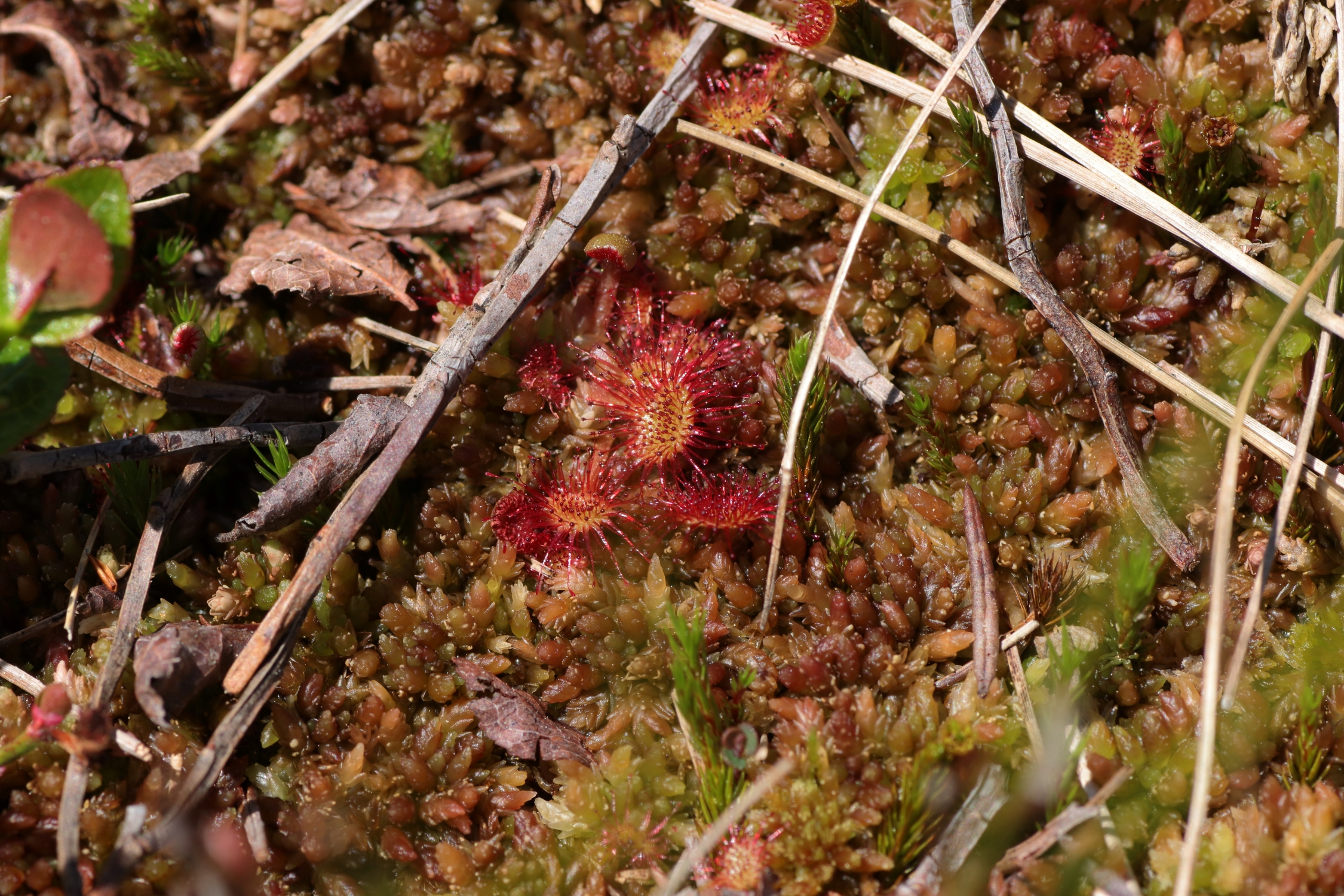The round-leaved sundew (Drosera rotundifolia) is one of the smallest carnivorous plants in the moor. However, you have to look very closely to find it. The small red leaves are striking.



Occurrence and distribution: Round-leaved sundew is dependent on meagre habitats such as raised bogs, fens and swamps, marshy springs and bog complexes. It grows only on nutrient-poor, calcareous and wet substrates. It is most common on the peat soils of bogs.
Plant description
Growth habit: The round-leaved sundew is a perennial herbaceous plant. It usually grows low to the ground and forms one or two stems with several flowers in the middle. The plant can reach a height of between 5 cm and 20 cm.
Leaves: Leaves arranged in rounded basal rosette. They have only short stems. Up to 200 tentacles form on the surface of the leaves. These are dark red in colour. The basic colour of the leaves is greenish yellow. A sticky sap forms on the surface of the trap leaves. This causes insects to stick to the trap leaves.
Flowers: Each stem produces up to 15 white flowers. These sit in a wide cluster at the end of the upright stem. Each flower has five white petals. They have a radial structure. A pale green stigma forms in the centre of the flowers. This is surrounded by five white stamens. The flowers are pollinated by flies and other Hymenoptera. In most cases the flowers are self-pollinated as they often do not open. However, insects are not only pollinators but also prey for the plant. The flowering period lasts from June to August.
The leaves as an insect trap
Insect trap: The small droplets of liquid on the leaves, which look like dew, act as a natural insect trap. If a hymenoptera gets caught in the droplets, the leaves contract towards the centre. At the centre of the leaves are the plant’s digestive organs. This is where the insects are dissolved and decomposed. The digestion process can take several days. This is how the plant obtains the nutrients it needs to survive in the nutrient-poor swamps.
Leaves as a food source
Leaves as a food source for caterpillars: The caterpillar of the european sundew moth (Buckleria paludum) feeds on the sticky leaves of the sundew species as well as the insects caught in them. The caterpillars themselves do not stick to the droplets on the leaves and can easily use them as a food source.
Leaves as food for the marsh grasshopper (Pseudochorthippus montanus): The leaves of the sundew are part of the diet of the rare marsh grasshopper. It is too large for the leaves of the small sundew and can therefore feed safely on them.
Former use of the plant
Former use as a colouring dye: In Scotland, a “purple” dye was once made from the plant in the Highlands. This was known as “lus-na-feàrnaich”. Evidence for this name can be found in the book „The illustrated Gaelic dictionary“ by Edward Dwelly on page 615.
Earlier use as a medicinal herb: As early as the 12th century, the Italian physician Matthaeus Platearius described the sundew plant as ‘herba sole‘ for treating dry coughs. In the past, the dried herb was used as a tea, tincture or extract. Today, the plant is no longer used medicinally due to its rarity.
Folk names & origin of names
Folk names: Round-leaved sundew is commonly known by a variety of names. These include ‘slime grass‘ (Schleimgras), ‘heath grass‘ (Heidengras), ‘farmer’s spoon‘ (Bauernlöffel) and ‘angelica‘ (Engelkraut). The name ‘slime grass‘ originates from the ‘dewdrops‘ on the leaves. These were associated with slime. In Scottish, the plant is known as ‘lus-an-feàrnaich‘. This can be explained as ‘plant with shields‘. It was given this name because of the shape of its leaves. The leaves bear a certain resemblance to a knight’s shield.
Origin of the botanical name: The botanical genus name “Drosera” is derived from the Greek word “δϱοσεϱός” (droseros) – meaning “dew” – or “δϱόσος” (drosos) – meaning “covered with dew”. This refers to the small glandular heads on the leaves. This gives them the appearance of dew.
Origin of the german name: The german name „rundblättriger Sonnentau“ (round-leaved sundew) is derived from the small droplets on the leaves. These are illuminated by the sunlight and can glisten like “dewdrops”. The leaves also have a rounded shape.
Endangerment of the plant
Endangerment of the plant: The round-leaved sundew is already categorised as endangered on the German Red List. Like all other sundew species, the round-leaved sundew is specially protected by the Federal Nature Conservation Act (BNatSchG) and the Federal Species Protection Ordinance (BArtSchV)! It should never be collected or damaged. The plant is also included in some regional Red Lists. The individual endangerment levels are as follows:
– Baden-Wuerttemberg: endangered (status: 3)
– Bavaria: endangered (status: 3)
– Berlin: threatened with extinction (status: 1)
– Brandenburg: pre-warning level (status: V)
– Hesse: critically endangered (status: 2)
– Hamburg: threatened with extinction (status: 1)
– Lower Saxony: endangered (status: 3)
– North Rhine-Westphalia: endangered (status: 3)
– Rhineland-Palatinate: endangered (status: 3)
– Saxony: critically endangered (status: 2)
– Saxony-Anhalt: critically endangered (status: 2)
– Saarland: threatened with extinction (status: 1)
– Schleswig-Holstein: endangered (status: 3)
– Thuringia: critically endangered (status: 2)
Distribution codes: A, AV, M1, M2, F, K